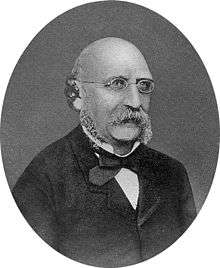Giovanni Battista de Rossi

Giovanni Battista (Carlo) de Rossi (23 February 1822 – 20 September 1894) was an Italian archaeologist, famous even outside his field for rediscovering early Christian catacombs.
Life and works
Born in Rome, he applied the sciences of archaeology and epigraphy, and leveraged his thorough knowledge of the topography of Rome, not to mention the resources of the Vatican Library, where he was employed cataloguing manuscripts. These skills he brought to Early Christian sites and guided the development of a new field, Christian archaeology. He travelled widely, knew all the museum collections intimately and was at the center of a network of professional friendships with all the European scholars of his fields.
In 1849 he rediscovered the lost Catacombs of Callixtus along the Via Appia Antica, with Alexander de Richemont. The catacombs were opened in the early 3rd century, as the principal Christian cemetery in Rome, where nine 3rd-century popes were buried. He published illustrations by Gregorio Mariani.
In 1877 he became foreign member of the Royal Netherlands Academy of Arts and Sciences.[1]
In 1888 de Rossi discovered that the Codex Amiatinus, the earliest surviving manuscript of the complete Bible in the Latin Vulgate version, was related to the Bibles mentioned by Bede. It was also established that the Codex Amiatinus was related to the Greenleaf Bible fragment in the British Library. For a thousand years the Codex Amiatinus was believed to be Italian in origin. It was only at that time that de Rossi discovered that the original inscription was that of Ceolfrith of the English.
He died at Castel Gandolfo.
Major works
- Inscriptiones christianae Urbis Romae septimo saeculo antiquiores (vol. I, Rome, 1861; part I of vol. II, Rome, 1888). His original plan was for a compendium of Christian inscriptions in the city of Rome of the first seven centuries. The series was continued after his death.
- La Roma Sotterranea Cristiana (vol. I with an atlas of forty plates, Rome, 1864; vol. II with an atlas of sixty-two and A, B, C, D plates, Rome, 1867; vol. III with an atlas of fifty-two plates, Rome, 1877). The plates for the fourth volume were already at the printer when De Rossi died. A Christian counterpart to an early classic of archaeology, Antonio Bosio's La Roma Sotterranea.
- Bullettino di archeologia cristiana. Six series of monographs and communications, which appeared monthly (1863–69), then quarterly (1870–75), (1876–81), then annually (1882–89), (1889–94), each series meticulously indexed.
- Mosaici delle chiese di Roma anteriori al secolo XV (Rome, 1872), a series of coloured lithographs with text in French and Italian illustrating the Late Antique and medieval mosaics of Rome.
- Codicum latinorum bibliothecae Vaticanae Rossi's manuscript indexes of the Latin codices are used as reference books in the Vatican Library.
- Inscriptiones Urbis Romae latinae volume VI of Corpus Inscriptionum Latinarum (Berlin) of which Rossi was one of the leading editors.
- Martyrologium Hieronymianum, edited with Louis Duchesne in vol. 1, November, of the Bollandists' Acta Sanctorum. (Brussels, 1894).
See also
- De Rossi: other people named de Rossi.
References
- ↑ "Giovanni Battista (Carlo) de Rossi (1822 - 1894)". Royal Netherlands Academy of Arts and Sciences. Retrieved 19 July 2015.
External links
| Wikimedia Commons has media related to Giovanni Battista de Rossi. |
- Catholic Encyclopedia 1908: Giovanni Battista de Rossi
- Chris Nyborg: "Catacombe di San Callisto"